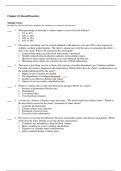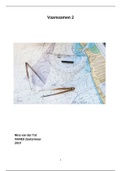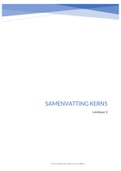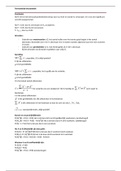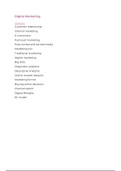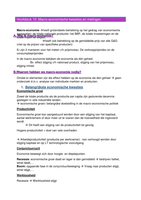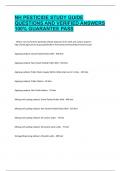Chapter 22, Renal Disorders
Multiple Choice
Identify the choice that best completes the statement or answers the question.
1. What percentage of the body’s cardiac output is received by the kidneys?
1. 5% to 10%
2. 20% to 25%
3. 30% to 35%
4. 45% to 50%
2. The nurse is providing care for a client admitted to the intensive care unit (ICU) after surgery for
multiple accident-related injuries. The client’s spouse asks why the nurse is measuring the client’s
urine every hour. What is the reason for the assessment?
1. Limited fluid intake can affect how much urine is produced.
2. Notable reduced urine production indicates serious kidney injury.
3. Blood loss from surgery and injuries can cause prerenal dysfunction.
4. Measuring urine output sets a goal for the rate of fluid replacement.
3. The nurse is providing care for a client with a history of insulin-dependent type 2 diabetes mellitus.
Currently, the client is diagnosed with renal failure. Which effect does the client’s condition have on
the insulin administered by the nurse?
1. Higher levels of insulin are needed.
2. The degradation of insuN linUiRs S
deIcN
reGasTeB
d..COM
3. Insulin is not effective during renal failure.
4. Glucose levels are totally controlled by diet.
4. Which is a likely cause of elevated blood urea nitrogen (BUN) in a client?
1. Increase in glomerular filtration rate
2. Dehydration
3. Low-protein diet
4. Very frail body structure
5. A client has a history of kidney stones and states, “My whole family has kidney stones.” Which is
the most likely reason for the client’s formation of renal calculi?
1. A genetic predisposition
2. Chronic urinary tract infection
3. Formation of gout crystals
4. Excessive bone reabsorption
6. The nurse is reviewing the difference between acute kidney injury and chronic renal failure. Which
client does the nurse identify as having chronic renal failure?
1. Condition was initiated by a drop in blood volume
2. Illness resulting in severe vomiting and diarrhea
3. Diagnosis of systemic lupus erythematosus
4. Injury acquired during a contact sport
, 7. Which statement made by a nurse pertains to the theory of protein deficiency as a possible cause of
the formation of renal calculi?
1. “A kidney stone is formed when crystalline constituents settle on uropontin.”
2. “Calcium phosphate deposition in the renal papilla leads to formation of a kidney
stone.”
3. “A Randall plaque is formed when a calcium phosphate compound settles in the
renal papilla.”
4. “There is a deficiency of the protein nephrocalcin, which inhibits stone formation.”
8. Which percentage of clients diagnosed with Goodpasture’s syndrome has clinically apparent
manifestations of pulmonary and renal disease?
1. 60% to 80%
2. 20% to 40%
3. Less than 10%
4. More than 90%
9. The nurse is providing care for a young adult client who has been diagnosed with Goodpasture’s
syndrome. Which does the nurse identify, when reviewing test results, as an indicator of the client
being at high risk for developing Goodpasture’s syndrome in the kidney and lungs?
1. HLA-DR2
2. HLA-DR3
3. ANCAs
4. Anti–glomerular basement membrane (GBM) antibodies
10. A client presents with a speN
ciU
ficRtSyI
peNoGf T
reBn.
alCcO
alM
culi that is not widely prevalent. The nurse knows
this client has been undergoing chemotherapy for the treatment of cancer. Which is an associated
characteristic of the type of renal calculi that is most likely to be present in this client?
1. Urine supersaturated with cystine
2. High purine levels in the bloodstream
3. Alkaline pH of urine
4. Pseudomonas infection in the urinary tract
11. The nurse is assessing the urinalysis report of a client of average build. Which observation definitely
indicates a state of illness in the client?
1. A serum creatinine level of 10 mg/dL
2. A blood urea nitrogen (BUN) level of 15 mg/dL
3. Casts in the urine
4. Slightly hazy urine
12. Which statement made by a nurse demonstrates understanding of the secretory functions of the
kidney?
1. “Clients with renal failure have higher hemoglobin levels because of constant
secretion of erythropoietin.”
2. “Kidneys create glucose from amino acids in case of excessive consumption of
animal proteins.”
3. “The juxtaglomerular apparatus secretes renin in response to high sodium levels in
the blood.”
4. “Clients with impaired renal function have disrupted calcium balance in the
, bloodstream due to inactive vitamin D.”
13. Which statement made by a nurse demonstrates understanding of the basic pathology of renal
disorders?
1. “Postrenal dysfunction can be accompanied by an increased risk of infection.”
2. “Prerenal dysfunction can be caused by excessive consumption of NSAIDs.”
3. “Intrarenal dysfunction can lead to hydronephrosis.”
4. “Postrenal dysfunction can result from severe hypovolemia.”
14. Which urinalysis finding indicates the client is experiencing renal dysfunction?
1. Urine is odorless and slightly hazy.
2. Urine is clear and amber-colored.
3. Urine is yellow, with a specific gravity of 1.001.
4. Urine contains crystals.
Multiple Response
Identify one or more choices that best complete the statement or answer the question.
15. A health-care provider is evaluating the urine and blood test reports of a client with a muscular body
structure. Which observations are most likely to indicate that the client is experiencing renal
impairment? Select all that apply.
1. High amount of leukocyte esterase
2. A blood urea nitrogen (BUN) of 25 mg/dL
3. Increased creatinine cleaNrU
anRcS
e INGTB.COM
4. Decreased creatinine clearance
5. High specific gravity of dilute urine
16. Which statements does the nurse identify as correct after contrasting peritoneal dialysis (PD) with
hemodialysis and continuous renal replacement therapy (CRRT)? Select all that apply.
1. In CRRT, the dialysis solution pulls wastes and extra fluid from the blood into the
abdominal cavity.
2. The dwell time in PD is 4 hours.
3. The entire blood volume circulates through the dialyzer in 30 to 40 minutes.
4. PD is a slower process used for clients who are hemodynamically unstable.
5. The process of draining and filling in PD takes about 30 to 40 minutes.
17. The nurse notices the glomerular filtration rate of a client has decreased. Which are the possible
reasons for this change? Select all that apply.
1. A decrease in the client’s blood pressure
2. An increase in the client’s blood pressure
3. A decrease in the client’s renal perfusion
4. An increase in the client’s renal perfusion
5. A part of the normal aging process
18. The nurse assesses a client for the presence of proteinuria. What observations indicate the client is
experiencing this condition? Select all that apply.
1. Protein excretion in urine of 130 mg/day
2. Protein excretion in urine of 200 mg/day
Multiple Choice
Identify the choice that best completes the statement or answers the question.
1. What percentage of the body’s cardiac output is received by the kidneys?
1. 5% to 10%
2. 20% to 25%
3. 30% to 35%
4. 45% to 50%
2. The nurse is providing care for a client admitted to the intensive care unit (ICU) after surgery for
multiple accident-related injuries. The client’s spouse asks why the nurse is measuring the client’s
urine every hour. What is the reason for the assessment?
1. Limited fluid intake can affect how much urine is produced.
2. Notable reduced urine production indicates serious kidney injury.
3. Blood loss from surgery and injuries can cause prerenal dysfunction.
4. Measuring urine output sets a goal for the rate of fluid replacement.
3. The nurse is providing care for a client with a history of insulin-dependent type 2 diabetes mellitus.
Currently, the client is diagnosed with renal failure. Which effect does the client’s condition have on
the insulin administered by the nurse?
1. Higher levels of insulin are needed.
2. The degradation of insuN linUiRs S
deIcN
reGasTeB
d..COM
3. Insulin is not effective during renal failure.
4. Glucose levels are totally controlled by diet.
4. Which is a likely cause of elevated blood urea nitrogen (BUN) in a client?
1. Increase in glomerular filtration rate
2. Dehydration
3. Low-protein diet
4. Very frail body structure
5. A client has a history of kidney stones and states, “My whole family has kidney stones.” Which is
the most likely reason for the client’s formation of renal calculi?
1. A genetic predisposition
2. Chronic urinary tract infection
3. Formation of gout crystals
4. Excessive bone reabsorption
6. The nurse is reviewing the difference between acute kidney injury and chronic renal failure. Which
client does the nurse identify as having chronic renal failure?
1. Condition was initiated by a drop in blood volume
2. Illness resulting in severe vomiting and diarrhea
3. Diagnosis of systemic lupus erythematosus
4. Injury acquired during a contact sport
, 7. Which statement made by a nurse pertains to the theory of protein deficiency as a possible cause of
the formation of renal calculi?
1. “A kidney stone is formed when crystalline constituents settle on uropontin.”
2. “Calcium phosphate deposition in the renal papilla leads to formation of a kidney
stone.”
3. “A Randall plaque is formed when a calcium phosphate compound settles in the
renal papilla.”
4. “There is a deficiency of the protein nephrocalcin, which inhibits stone formation.”
8. Which percentage of clients diagnosed with Goodpasture’s syndrome has clinically apparent
manifestations of pulmonary and renal disease?
1. 60% to 80%
2. 20% to 40%
3. Less than 10%
4. More than 90%
9. The nurse is providing care for a young adult client who has been diagnosed with Goodpasture’s
syndrome. Which does the nurse identify, when reviewing test results, as an indicator of the client
being at high risk for developing Goodpasture’s syndrome in the kidney and lungs?
1. HLA-DR2
2. HLA-DR3
3. ANCAs
4. Anti–glomerular basement membrane (GBM) antibodies
10. A client presents with a speN
ciU
ficRtSyI
peNoGf T
reBn.
alCcO
alM
culi that is not widely prevalent. The nurse knows
this client has been undergoing chemotherapy for the treatment of cancer. Which is an associated
characteristic of the type of renal calculi that is most likely to be present in this client?
1. Urine supersaturated with cystine
2. High purine levels in the bloodstream
3. Alkaline pH of urine
4. Pseudomonas infection in the urinary tract
11. The nurse is assessing the urinalysis report of a client of average build. Which observation definitely
indicates a state of illness in the client?
1. A serum creatinine level of 10 mg/dL
2. A blood urea nitrogen (BUN) level of 15 mg/dL
3. Casts in the urine
4. Slightly hazy urine
12. Which statement made by a nurse demonstrates understanding of the secretory functions of the
kidney?
1. “Clients with renal failure have higher hemoglobin levels because of constant
secretion of erythropoietin.”
2. “Kidneys create glucose from amino acids in case of excessive consumption of
animal proteins.”
3. “The juxtaglomerular apparatus secretes renin in response to high sodium levels in
the blood.”
4. “Clients with impaired renal function have disrupted calcium balance in the
, bloodstream due to inactive vitamin D.”
13. Which statement made by a nurse demonstrates understanding of the basic pathology of renal
disorders?
1. “Postrenal dysfunction can be accompanied by an increased risk of infection.”
2. “Prerenal dysfunction can be caused by excessive consumption of NSAIDs.”
3. “Intrarenal dysfunction can lead to hydronephrosis.”
4. “Postrenal dysfunction can result from severe hypovolemia.”
14. Which urinalysis finding indicates the client is experiencing renal dysfunction?
1. Urine is odorless and slightly hazy.
2. Urine is clear and amber-colored.
3. Urine is yellow, with a specific gravity of 1.001.
4. Urine contains crystals.
Multiple Response
Identify one or more choices that best complete the statement or answer the question.
15. A health-care provider is evaluating the urine and blood test reports of a client with a muscular body
structure. Which observations are most likely to indicate that the client is experiencing renal
impairment? Select all that apply.
1. High amount of leukocyte esterase
2. A blood urea nitrogen (BUN) of 25 mg/dL
3. Increased creatinine cleaNrU
anRcS
e INGTB.COM
4. Decreased creatinine clearance
5. High specific gravity of dilute urine
16. Which statements does the nurse identify as correct after contrasting peritoneal dialysis (PD) with
hemodialysis and continuous renal replacement therapy (CRRT)? Select all that apply.
1. In CRRT, the dialysis solution pulls wastes and extra fluid from the blood into the
abdominal cavity.
2. The dwell time in PD is 4 hours.
3. The entire blood volume circulates through the dialyzer in 30 to 40 minutes.
4. PD is a slower process used for clients who are hemodynamically unstable.
5. The process of draining and filling in PD takes about 30 to 40 minutes.
17. The nurse notices the glomerular filtration rate of a client has decreased. Which are the possible
reasons for this change? Select all that apply.
1. A decrease in the client’s blood pressure
2. An increase in the client’s blood pressure
3. A decrease in the client’s renal perfusion
4. An increase in the client’s renal perfusion
5. A part of the normal aging process
18. The nurse assesses a client for the presence of proteinuria. What observations indicate the client is
experiencing this condition? Select all that apply.
1. Protein excretion in urine of 130 mg/day
2. Protein excretion in urine of 200 mg/day

